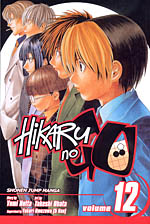 Written by Yumi Hotta
Written by Yumi Hotta
Art by Takeshi Obata
200 pages, black and white
Published by Viz
There are some series that, over time, I’ve grown bored with. It’s the same thing over and over again, and I’ve just hit that point where I don’t care. Twelve volumes in, though, I find myself a little amazed (and quite pleased) that this is anything but the case for Hikaru no Go. Yumi Hotta and Takeshi Obata have just crossed the halfway point for their saga to master a board-game, and I’m dying to see just what happens next.
Hikaru Shindo has finally done it, getting the incredibly grueling tournament to become a professional go player. That doesn’t meant that his life is going to get any easier, though. Now even more eyes are on him, which is bad if you’re trying to hide the existence of your ghostly mentor Sai. If that’s not trouble enough, though, Sai is starting to wonder if Hikaru will ever let him play the game again—and that conflict could be the end of Hikaru’s new career before it ever really begins.
What impresses me about Hotta’s writing is that she’s not afraid to change the setup of her series as needs be. Some characters drop out as Hikaru’s story and skills change, other new ones arrive. Even what was an early, fundamental thrust of the book—Sai playing for Hikaru—is addressed here, with them trying to find a balance so Hikaru can continue to learn while still keeping Sai happy. I like that Hotta recognizes that the relationship would have to change, and comes up with inventive ways to keep both characters happy, while at the same time letting a conflict stick around that will help keep readers interested. With each new volume, Hikaru’s world is expanding just a little bit more as he takes another step into the world of go, and I’m amazed and pleased on how Hotta’s managed to keep my interest in a story about a game that I really don’t even know how to play beyond the absolute basics.
Obata’s art, just like in Death Note, continues to be top-notch. There’s a great panel early on where Hikaru has spread out numerous go magazines for the ghostly Sai to look at. Hikaru sits cross-legged, looking surprised as he reads one article while Sai is bent over, hands on the floor, entranced by what’s in front of him. It’s a beautiful drawing, with Sai coming across serene and calm while Hikaru is excitable and full of life. It provides a great contrast between the two characters, as well as a good reference point with which to compare Sai when even he becomes more wound up and excited.
It’s hard to explain entirely why Hikaru no Go is so attention-grabbing, other than to say that Hotta and Obata do everything right. There are very few series that run over 20 volumes in length that have even a chance of keeping my attention that long, but clearly Hikaru no Go is one of the exceptions. If you haven’t tried this series out, trust me, it’s among the cream of the crop. Highly recommended.
Purchase Links: Amazon.com
